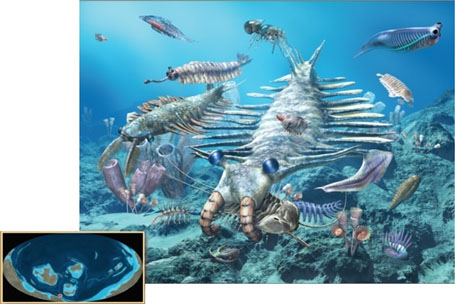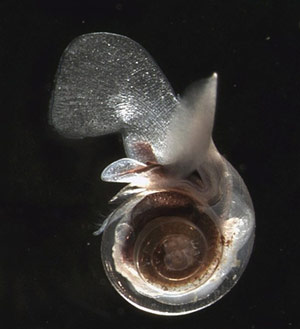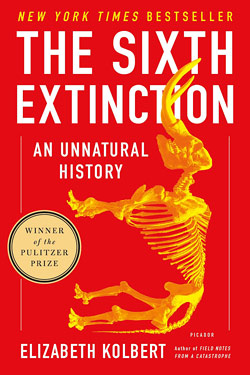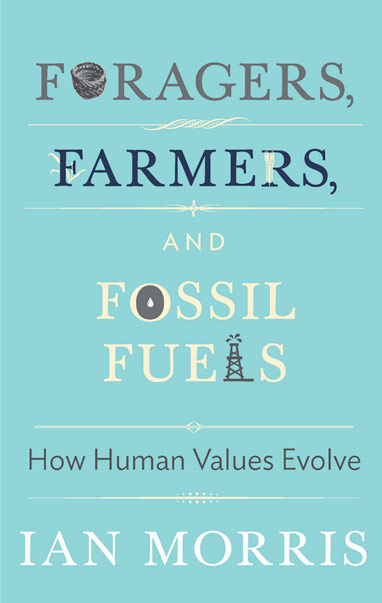
A Short History of the Climate and Extinction
The position of the continents, the pattern of ocean currents, the environment that was in place when the climate began to change, none of these have ever been the same as they are now. But one lesson does stand out in this long history—when the climate changes quickly, many things die.
…when the climate changes quickly, many things die.
Before 550 million years ago, conditions were so different that it’s best to think of that ancient Earth as if it were an alien planet. At times all of the land was stuck together near the south pole; even the days were shorter because the Earth was spinning faster. There was little oxygen in the atmosphere; most life was simple and single-celled. Life—and the planet itself—changed dramatically when multi-cell life first appeared, a time known as the Cambrian Explosion. Whatever we might learn from the past that could apply to our own climate must come from studying the 500 million years since then.

artist: Masato Hattori, USGS
The main force controlling the climate is the amount of energy from the Sun that reaches the Earth’s surface. The energy output of the Sun has been remarkably constant since the Cambrian Explosion, but the amount of that energy reaching the Earth changes regularly because the Earth’s orbit changes. For example, the tilt of the Earth’s axis changes back and forth a total of 2.5° over about 41,000 years. This changes the difference between summer and winter weather. Today the trend from this effect alone would be toward cooler summers and warmer winters.

Other small orbital variations also repeat regularly over many tens of thousands of years. These “Milankovitch cycles” cause the solar energy reaching the Earth to change very slowly and predictably. But at rare and unpredictable times, the climate system has suffered great shocks from events such as asteroid collisions and volcanic activity. Scientists are studying the events that caused large amounts of CO2 to be suddenly released into the environment, hoping to gain insight into our climate future.
The Great Dying
Since the Cambrian Explosion there have been five mass extinctions when a great shock caused the majority of all life to disappear. The best known of these was the Cretaceous–Tertiary (K–T) Extinction 66 million years ago, when the Chicxulub asteroid, the size of Mt. Everest, smashed into the Gulf of Mexico and caused the dinosaurs to disappear.
Since the Cambrian Explosion there have been five mass extinctions when a great shock caused the majority of all life to disappear.
When all the dinosaurs died following the asteroid impact, 75% of all other species died out, too. What killed them all was the world-wide change in climate. A “mass extinction” is when at least 50% of all animal species on land and sea become extinct. Note that the loss of each species can mean the death of millions of individual creatures.
Mass extinctions happen suddenly in geological terms but still span many thousands of years. The K–T Extinction was unusual in that it happened so quickly, even in human terms, demonstrating clearly that life is interconnected and can be fragile.
About 225 million years ago, 95% of marine species and 70% of land species disappeared forever.
The largest of the five mass extinction events was the End-Permian Extinction (EPE) which has been called “The Great Dying.” About 225 million years ago, 95% of marine species and 70% of land species disappeared forever. A great spike in atmospheric CO2 laced the oceans with carbonic acid, a process called ocean acidification. This in turn released toxins from the seas, turning the air purple and noxious. There are several possible causes for the sudden increase in the CO2, including massive volcanic activity in Siberia.
Many other extinctions have killed less than 50% of life. One example is the Paleocene–Eocene Thermal Maximum (PETM) that happened about 10 million years after the dinosaurs died out. The PETM killed off “only” about one third of all species. Global temperatures during the PETM rose 5–8°C, the most extreme increase in the Earth’s temperature in the last 60 million years. It was likely caused by the release of great quantities of methane, a greenhouse gas at least 25 times more powerful at warming the planet than CO2.
The Climate Gun
Today much methane is locked in frozen soil near the poles and in the ocean floors in a chemical complex called a “clathrate,” a sort of cage of ice.
This PETM event offers enough similarities to our changing climate that it has become the subject of intensive study. Today much methane is locked in frozen soil near the poles and in the ocean floors in a chemical complex called a “clathrate,” a sort of cage of ice. Clathrates are only stable at cold temperatures and under pressure; when the clathrate melts, the methane is released. This also leads to great increases in CO2 in the atmosphere.

Artist: Russ Hopcroft, NOAA
The potential of a methane release to warm the Earth and acidify the oceans is called the “clathrate gun.” Its effects on land during the PETM were relatively muted, but the consequences for marine life were disastrous. The increased amounts of CO2 absorbed into seawater made it more acidic, which killed off most deep-sea crustaceans, molluscs, corals, and related organisms. The clathrate gun likely played a role in the earlier Great Dying as well. Oceans today are becoming more acidic many times faster than during either the Great Dying or the PETM.
The Human Asteroid
The loss of several species each year is a part of the natural cycle of life. As the environment gradually changes, some mutations prove more fit for the new conditions than others. Animals and plants, predators and prey, together evolve strategies to adapt and survive in balance. But mass extinctions are different because the sudden shock to the environment leaves no time for species to adapt. The most fit are destroyed along with the least fit, and it takes millions of years for life to regain its diversity.
Today we are witnessing what could well turn out to be the sixth mass extinction event: “the Holocene extinction.”
A mass extinction requires multiple causes though—even one such as the K–T Extinction, which killed off the dinosaurs. Today we are witnessing what could well turn out to be the sixth mass extinction event: “the Holocene Extinction.” This is the first such event not caused by volcanic eruptions or an asteroid impact or other natural occurrences. The Holocene Extinction is being caused by the combination of habitat loss, pesticide use, over-fishing and over-hunting, and invasive species and diseases introduced where they did not evolve—all the result of human activity.
The rate at which species are being lost today is estimated to be as much as 1,ooo times higher than would be happening in the absence of humans. Note that global warming is not included in the list of causes. Global warming and its side effects such as ocean acidification are only just beginning to impact the biosphere. Without mitigating the effects of burning fossil fuels before climate change fully unfolds, the death rate of species in the Holocene Extinction will soar.
As tragic as this predicament is, it may not reach the same the scale as the five mass extinctions. But not many species would need to die out for humans to be in trouble, maybe just a few — say, wheat and rice. While our species is robust and adaptable to changing conditions, our civilization, which is dependent on industrial scale agriculture, is not. We can still prevent the worst from happening, and we must. Otherwise, in the words of renowned science writer Elizabeth Kolbert, this time “we’re the asteroid.”

The Sixth Extinction
An Unnatural History
Elizabeth Kolbert
With all of Earth’s five mass extinctions, the climate changed faster than any species could adapt. The current extinction has the same random and rapid properties, but it’s unique in that it’s caused entirely by the actions of a single species—humans.

Foragers, Farmers, and Fossil Fuels
Ian Morris
Human social development, says Morris, is constantly generated by environmental and social factors. The amount of energy that can be extracted from the environment through technology defines the social possibilities, and thus influences the attitudes and world view of each epoch.
In the series: Our Finite Planet
Related articles:
Further Reading »
External Stories and Videos

Watch: Cosmic Knowledge and the Future of the Human Race
Sandra Faber, Kraw Lecture Series, UC Santa Cruz
National Medal of Science winner Sandra Faber describes how the profound insights of cosmology take the issue of sustainability out of the personal and into a more objective consideration of where – and if – we are going.

Watch: David Wallace-Wells | The Uninhabitable Earth
Extinction Radio
Famine, economic collapse, a sun that cooks us: What climate change could wreak — sooner than you think.

